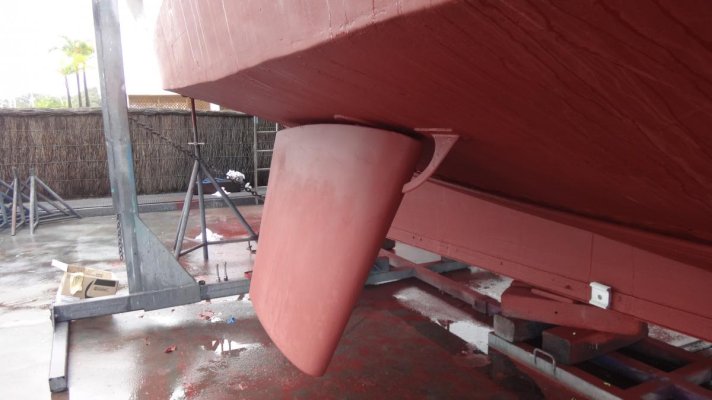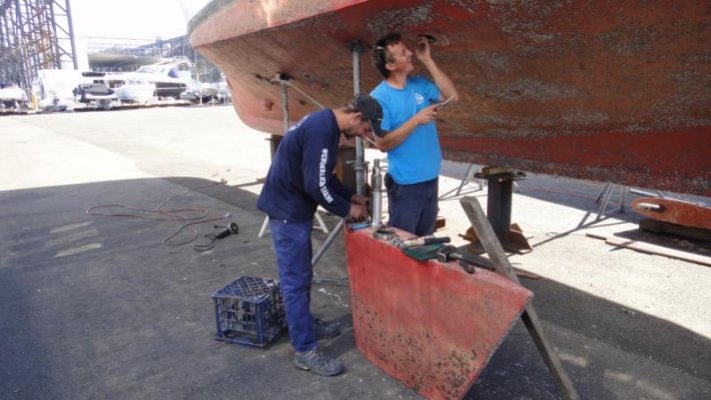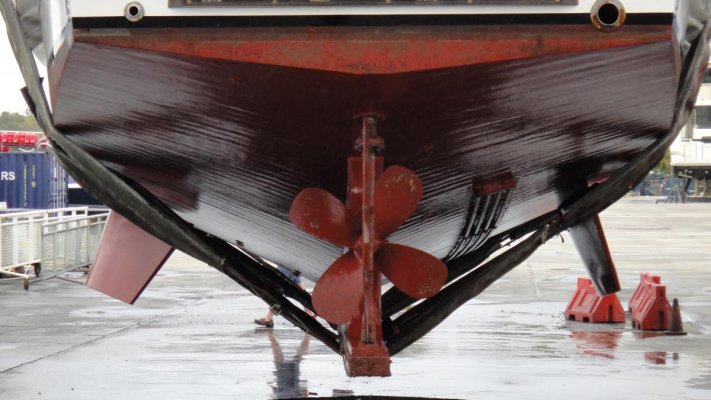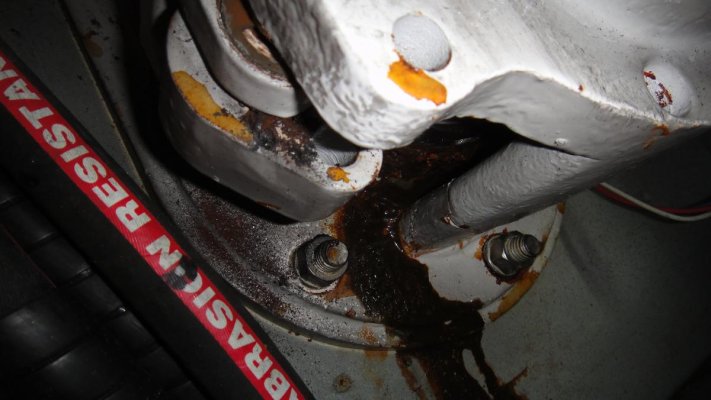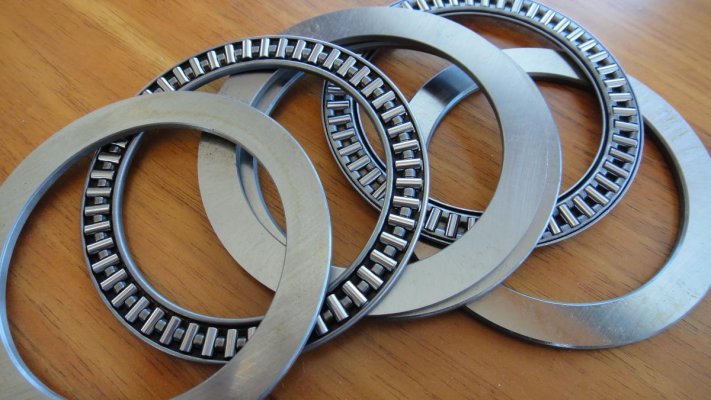Getting sea trial in the Keys for 1987 45' Tayana trawler we made offer on (was accepted). Everything seems great about her, but it does not have stabilizers. Any thoughts about this invited. Pros and cons, what to do, what NOT to do and where NOT to go (Not crossing any oceans). Thanks!
You are using an out of date browser. It may not display this or other websites correctly.
You should upgrade or use an alternative browser.
You should upgrade or use an alternative browser.
Stabilizers necessary?
- Thread starter Aprokan
- Start date
The friendliest place on the web for anyone who enjoys boating.
If you have answers, please help by responding to the unanswered posts.
If you have answers, please help by responding to the unanswered posts.
Getting sea trial in the Keys for 1987 45' Tayana trawler we made offer on (was accepted). Everything seems great about her, but it does not have stabilizers. Any thoughts about this invited. Pros and cons, what to do, what NOT to do and where NOT to go (Not crossing any oceans). Thanks!
It's a borderline size of stablizers or not. You'll have to determine on your own. If you're just cruising the ICW or coastal waters you won't miss them when it's quiet but when dealing with the wake of other boats you might. If docking at marinas no big deal. Anchoring, the roll may or may not bother you. If you cruise offshore, you may well wish you had them but you can also learn how to tack and different approaches to offset not having them. Generally the advice would be try it and enjoy it. Then if you feel some compelling need, add them. Likely you never will.
RT Firefly
Enigma
Greetings,
Welcome aboard. Interesting place for the galley. First think that comes to mind is it appears there is only one method of entry or egress from said galley.
NOT a good thing if one ever has a stove fire. Otherwise, looks good.
I wouldn't worry too much about stabilization unless you or the Admiral find the motion uncomfortable. On the sea trial, make an effort to ride in a beam sea.
Welcome aboard. Interesting place for the galley. First think that comes to mind is it appears there is only one method of entry or egress from said galley.
NOT a good thing if one ever has a stove fire. Otherwise, looks good.
I wouldn't worry too much about stabilization unless you or the Admiral find the motion uncomfortable. On the sea trial, make an effort to ride in a beam sea.
Al
Guru
- Joined
- Apr 1, 2012
- Messages
- 2,206
- Location
- usa
- Vessel Name
- 'SLO'~BELLE
- Vessel Make
- 1978 Marben-27' Flybridge Trawler(extended to 30 feet) Pilothouse Pocket Cruiser[
Greetings,
Welcome aboard. Interesting place for the galley. First think that comes to mind is it appears there is only one method of entry or egress from said galley.
NOT a good thing if one ever has a stove fire. Otherwise, looks good.
I wouldn't worry too much about stabilization unless you or the Admiral find the motion uncomfortable. On the sea trial, make an effort to ride in a beam sea.
I echo Firefly's welcome to the forum. With regards to the stabilization I would add the test of a quartering sea aft to ascertain the action. Full tanks or not should be calculated as well in any sea trial.
As to the galley observation- Man, if this is the boat for sale in Florida that I just looked up, those stairs are going to be grief to the cook let me tell you! Having had a smaller boat where the galley was located in the pilothouse, every time I wished to do anything other than sit, the chair had to be moved to the point that I called the operation 'Dancing with the Chair'. The point being the stairs are an obstacle not easily dealt with.
Nice boat otherwise for sure.
Regards,
Al-Ketchikan
HopCar
Guru
- Joined
- Aug 20, 2011
- Messages
- 5,308
- Vessel Name
- Possum
- Vessel Make
- Ellis 28
Welcome aboard. I wouldn't rush into installing stabilizers. After all, the boat has managed without them for thirty years. Use it a while, then decide if you want to add stabilizers.
Simi 60
Guru
- Joined
- Jul 1, 2016
- Messages
- 5,482
- Location
- Australia
- Vessel Make
- Milkraft 60 converted timber prawn trawler
Tacking helps.
30 knots here at the moment and some nice wind against tide wave action had us rolling if taking a direct route to our destination.
Instead we adjusted course and punched across it @ 45 deg. for a bit before turning and running with it.
Added a few miles but the trip was far more comfortable.
30 knots here at the moment and some nice wind against tide wave action had us rolling if taking a direct route to our destination.
Instead we adjusted course and punched across it @ 45 deg. for a bit before turning and running with it.
Added a few miles but the trip was far more comfortable.
My current boat has active fin stabilisers and although I enjoyed fifty years of coastal cruising in all sorts of boats totally unaware of the joys of stabilisers, I now wouldn't leave home without them.
BUT active fin stabilisers mean major maintenance. My fins are moving 40 tons of wood, so seals and bearings are replaced every two years, as well as constant monitoring of mechanics, hydraulics and electronics.
Oh yes, fin-wise, depending on the angle of your dangle, extra care when gunkholing maybe needed.
BUT active fin stabilisers mean major maintenance. My fins are moving 40 tons of wood, so seals and bearings are replaced every two years, as well as constant monitoring of mechanics, hydraulics and electronics.
Oh yes, fin-wise, depending on the angle of your dangle, extra care when gunkholing maybe needed.
Attachments
Gordon J
Guru
- Joined
- Jul 23, 2015
- Messages
- 1,081
- Location
- USA
- Vessel Name
- Didi Mau
- Vessel Make
- Currently looking for next boat
Don't leave home without em
The question about stabilizers has more to do with money than about any other thing. There is no question that you will have a better ride. I don't find maintenance to be onerous. My Trac stabilizers require servicing every six years. Figure two days to perform service first time.
I don't think i would own a trawler that was unstabilized. We bought our ocean alexander 456 classico with stabilizers installed by PO. I think it is the most valuable feature on the boat.
Gordon
The question about stabilizers has more to do with money than about any other thing. There is no question that you will have a better ride. I don't find maintenance to be onerous. My Trac stabilizers require servicing every six years. Figure two days to perform service first time.
I don't think i would own a trawler that was unstabilized. We bought our ocean alexander 456 classico with stabilizers installed by PO. I think it is the most valuable feature on the boat.
Gordon
Simi 60
Guru
- Joined
- Jul 1, 2016
- Messages
- 5,482
- Location
- Australia
- Vessel Make
- Milkraft 60 converted timber prawn trawler
The question about stabilizers has more to do with money than about any other thing.
Yep.
And with that in mind may I say one word.
MULTIHULL.
Have had them, have cruised them, have raced them, have crossed oceans in them and if you can justify the dollars there is no contest in my eyes.
Fletcher500
Guru
I didn't want to jump in until the PO received his reply. It appears he has, so I will jump in.
I am thinking about this with the purchase of a new 45 foot trawler. I have spent zero time on stabilized anything, so it is all anecdotal and what I read in a magazine.
So are these new trac systems fairly maintenance free?
How often do you need to go into the yard to service them?
If the unit fails and you are a long way from Port, can one of these fins potentially get stuck in a cockeyed position. IE, seriously affecting your trim and ability to steer?
I really like the idea of a smoother ride. As I've gotten older I am a bit more susceptible to to snotty weather but the cost, maintenance, and concerns with them locking up somehow are concerning.
I am thinking about this with the purchase of a new 45 foot trawler. I have spent zero time on stabilized anything, so it is all anecdotal and what I read in a magazine.
So are these new trac systems fairly maintenance free?
How often do you need to go into the yard to service them?
If the unit fails and you are a long way from Port, can one of these fins potentially get stuck in a cockeyed position. IE, seriously affecting your trim and ability to steer?
I really like the idea of a smoother ride. As I've gotten older I am a bit more susceptible to to snotty weather but the cost, maintenance, and concerns with them locking up somehow are concerning.
HenryD
Senior Member
- Joined
- Dec 16, 2012
- Messages
- 477
- Location
- USA
- Vessel Name
- Seven Tenths (sold)
- Vessel Make
- Mirage / Great Harbour 47
My boat does not have stabilizers. Before we bought our boat, we tried several boats including a Grand Banks that had stabilizers. We were fortunate to take it out in 3-4' seas and felt the amazing ability of the stabilizers to change the ride from rocky, lumpy to riding smooth as if on rails. In the end, we liked other aspects of our Great Harbour and bought her. As I look back on our travels in the past 10 yrs, we have handled some snotty weather without stabilizers by keeping a good eye on the weather, staying at the dock or anchor planning for a better day. We have run some in the Atlantic up the east coast, have done the Loop, the Little Triangle, and the ICW many times. Depending what you plan to do with the boat, I would not worry about the stabilizers or lack of them. You will find when your boat does well and when you do not go. Good luck with your new boat.
Fletcher500
Guru
Did the GB have the fins, or a Gyro/seakeeper?
On a more general note, I would assume these systems primary function is to dampen the 1-2 ft. high frequency chop generated by wind?
IE, for longer period deep ocean swells in the 2-5 ft. range, the boat will not behave much different with stab's?
On a more general note, I would assume these systems primary function is to dampen the 1-2 ft. high frequency chop generated by wind?
IE, for longer period deep ocean swells in the 2-5 ft. range, the boat will not behave much different with stab's?
My boat does not have stabilizers. Before we bought our boat, we tried several boats including a Grand Banks that had stabilizers. We were fortunate to take it out in 3-4' seas and felt the amazing ability of the stabilizers to change the ride from rocky, lumpy to riding smooth as if on rails. In the end, we liked other aspects of our Great Harbour and bought her. As I look back on our travels in the past 10 yrs, we have handled some snotty weather without stabilizers by keeping a good eye on the weather, staying at the dock or anchor planning for a better day. We have run some in the Atlantic up the east coast, have done the Loop, the Little Triangle, and the ICW many times. Depending what you plan to do with the boat, I would not worry about the stabilizers or lack of them. You will find when your boat does well and when you do not go. Good luck with your new boat.
A recent crossing of the Gulf of Georgia demonstrated the utility of stabilizers.
We were passed, on a parallel course, by a larger boat with stabilizers. We were heading about 15° into a sea that rose to 1.5m with a few over 2m. Our motion was mainly pitching, with a very small amount of rolling. I was happy with that motion and not tempted to reduce the 15° to eliminate the rolling. About 1/2 way across (a 3 hr crossing) the boat with stabilizers was on the radio to explain to an unseen travelling companion that he was going to alter course to take the seas on the beam, to eliminate the pitching motion that he found unacceptable. He was counting on the stabilizers to completely deal with the rolling that would ordinarily have made that course alteration unacceptable. Had I made the same course alteration in my non-stabilized boat, the rolling would have been severe. The pitching we were experiencing was requiring the wipers to be on most of the time, and left the entire boat covered in salt by the time we left the open Strait. It also cost almost 2 knots in speed.
We were passed, on a parallel course, by a larger boat with stabilizers. We were heading about 15° into a sea that rose to 1.5m with a few over 2m. Our motion was mainly pitching, with a very small amount of rolling. I was happy with that motion and not tempted to reduce the 15° to eliminate the rolling. About 1/2 way across (a 3 hr crossing) the boat with stabilizers was on the radio to explain to an unseen travelling companion that he was going to alter course to take the seas on the beam, to eliminate the pitching motion that he found unacceptable. He was counting on the stabilizers to completely deal with the rolling that would ordinarily have made that course alteration unacceptable. Had I made the same course alteration in my non-stabilized boat, the rolling would have been severe. The pitching we were experiencing was requiring the wipers to be on most of the time, and left the entire boat covered in salt by the time we left the open Strait. It also cost almost 2 knots in speed.
dhays
Guru
- Joined
- May 26, 2015
- Messages
- 9,045
- Location
- United States
- Vessel Name
- Kinship
- Vessel Make
- North Pacific 43
Stabilizers would be nice so I wouldn't have to listen to my wife complain about the rolling.
As Keith pointed out, sometimes without stabilizers you have to take a course that is more directly into the seas than you would like just avoid bad rolling. Since for me this is only an issue a few times a year, it wouldn't be worth the cost or maintenance.
As Keith pointed out, sometimes without stabilizers you have to take a course that is more directly into the seas than you would like just avoid bad rolling. Since for me this is only an issue a few times a year, it wouldn't be worth the cost or maintenance.
Gulf Comanche
Guru
- Joined
- Dec 16, 2007
- Messages
- 1,045
- Location
- U.S.A.
- Vessel Name
- Old School
- Vessel Make
- 38' Trawler custom built by Hike Metal Products
I have paravane stabilizers on Old School and had them in the water a couple weeks ago crossing Lake Ponchartrain. It's a shallow lake, 15-18', and when the waves build they can get to 4-6' on a bad day. When I crossed it was 2-4' at 4 seconds and waves getting bigger during the last hour, its the 4 seconds that really count. Even w/ the fish in the water it was a rough ride, sometimes beam seas, sometimes rear quarter. Point is, they help but not a cure all.
Gordon J
Guru
- Joined
- Jul 23, 2015
- Messages
- 1,081
- Location
- USA
- Vessel Name
- Didi Mau
- Vessel Make
- Currently looking for next boat
Service
Trac service is to change seals, bearings and lube every six years. You have to drop the finds to do this. The fins can be locked in the center position manually if everything fails. Also, there is an impeller to change on the hydraulic oil cooler. I would guess every two years or so.
Our stabilizers are run off a hydraulic pump attached to the front of the engines. If one engine were to fail, i would switch to the pump on the working engine. Also, it is possible to use only one fin, should the other become damaged or inop.
My feeling is that of course you can do without stabilizers. I waited until I found a reasonably priced boat that met my needs and had them installed by previous Owner.
I didn't want to jump in until the PO received his reply. It appears he has, so I will jump in.
I am thinking about this with the purchase of a new 45 foot trawler. I have spent zero time on stabilized anything, so it is all anecdotal and what I read in a magazine.
So are these new trac systems fairly maintenance free?
How often do you need to go into the yard to service them?
If the unit fails and you are a long way from Port, can one of these fins potentially get stuck in a cockeyed position. IE, seriously affecting your trim and ability to steer?
I really like the idea of a smoother ride. As I've gotten older I am a bit more susceptible to to snotty weather but the cost, maintenance, and concerns with them locking up somehow are concerning.
Trac service is to change seals, bearings and lube every six years. You have to drop the finds to do this. The fins can be locked in the center position manually if everything fails. Also, there is an impeller to change on the hydraulic oil cooler. I would guess every two years or so.
Our stabilizers are run off a hydraulic pump attached to the front of the engines. If one engine were to fail, i would switch to the pump on the working engine. Also, it is possible to use only one fin, should the other become damaged or inop.
My feeling is that of course you can do without stabilizers. I waited until I found a reasonably priced boat that met my needs and had them installed by previous Owner.
Bay Pelican
Moderator Emeritus
Krogen's roll. The difference with and without stabilizers is substantial with Bay Pelican. On a 30 year old boat for the east coast I would not invest the money. If you were on the west coast of the United States or going to the Caribbean (not the Bahamas), or up to Atlantic Canada/Maine it would be worthwhile.
Fletcher500
Guru
Krogen's roll. The difference with and without stabilizers is substantial with Bay Pelican. On a 30 year old boat for the east coast I would not invest the money. If you were on the west coast of the United States or going to the Caribbean (not the Bahamas), or up to Atlantic Canada/Maine it would be worthwhile.
Copy that, some people don't realize the Pacific Ocean can get fairly snotty, even in SoCal. I spent time on ships when I was younger and some of the worst weather we experienced was of the Central Coast, just north of Santa Barbara.
I still know enough to be dangerous about the subject. I am hoping to get out on a boat eventually with them, and more reading.
Tough call to make considering the expense. Also, coming off light weight ECs, I always said the next one would be as bullet proof as possible, with the least amount of moving parts as possible.
Sealife
Guru
Fletcher,
On my boat (heavy w/ long roll period), I find the short steep chop to not affect the hull due to different roll periods. It is the longer, larger swell that makes me use the stabilizers, due to roll periods syncing up.
Make sense?
On my boat (heavy w/ long roll period), I find the short steep chop to not affect the hull due to different roll periods. It is the longer, larger swell that makes me use the stabilizers, due to roll periods syncing up.
Make sense?
Fletcher500
Guru
Fletcher,
On my boat (heavy w/ long roll period), I find the short steep chop to not affect the hull due to different roll periods. It is the longer, larger swell that makes me use the stabilizers, due to roll periods syncing up.
Make sense?
I am trying to visualize it, but having trouble. I need to go the manufacturer site and learn more, than I should be able to understand what you are saying. I have been spending most of my free time looking at the other systems for the new boat purchase, and have not done the proper Stab research yet.
All good though, and I appreciate the feedback.
OP-I waited a few days before I started to ask questions because I did not want to high jack your thread. Rather than starting a new one, figured I would just jump in and hopefully some of the Q/A is also helpful for you.
AusCan
Guru
- Joined
- Jul 15, 2012
- Messages
- 3,218
- Location
- Australia
- Vessel Name
- Kokanee
- Vessel Make
- Cuddles 30 Pilot House Motor Sailer
Fletcher,
On my boat (heavy w/ long roll period), I find the short steep chop to not affect the hull due to different roll periods. It is the longer, larger swell that makes me use the stabilizers, due to roll periods syncing up.
Make sense?
Exactly,
A longer roll period is more comfortable, although if it is too long it begins to decrease stability. Most boats have a roll period in seconds equal to about 1/3 of their beam in feet.
Lets say the boat's natural roll period is 5 seconds. A swell period of 4 seconds or 6 seconds will have a somewhat limited effect on the boat. But if the swell period is 5 seconds there will be problems. A swell period of 2.5 or 10 may also multiply the rolling effect in some circumstances because there is occasional synchronization of movement.
Last edited:
Fletcher500
Guru
Exactly,
A longer roll period is more comfortable, although if it is too long it begins to decrease stability. Most boats have a roll period in seconds equal to about 1/3 of their beam in feet.
Lets say the boat's natural roll period is 5 seconds. A swell period of 4 seconds or 6 seconds will have a somewhat limited effect on the boat. But if the swell period is 5 seconds there will be problems. A swell period of 2.5 or 10 may also multiply the rolling effect in some circumstances because there is occasional synchronization of movement.
Offshore CA deep swell periods are 10 to 15 seconds. Big swells can be 18 or more...just a rough estimate.
I equate a 2.5 period to wind chop.
Are you saying you have swell periods of 2.5 to 10 seconds?
AusCan
Guru
- Joined
- Jul 15, 2012
- Messages
- 3,218
- Location
- Australia
- Vessel Name
- Kokanee
- Vessel Make
- Cuddles 30 Pilot House Motor Sailer
Offshore CA deep swell periods are 10 to 15 seconds. Big swells can be 18 or more...just a rough estimate.
I equate a 2.5 period to wind chop.
Are you saying you have swell periods of 2.5 to 10 seconds?
Our swell can be anywhere from 2 seconds to 20 seconds. Sometimes there are 2 swells at differing intervals and directions with winds from a third direction, so it can get very short and confused, especially in the backstairs passage where I do a lot of boating. https://en.wikipedia.org/wiki/Backstairs_Passage.
Fletcher - I find the the that it is easiest to understand the relationship between boat and swell is when anchored and the wind blows you beam to the swell. It might be no problem for a while, then the gentle rock suddenly just gets bigger and bigger. There has been no noticeable change to the swell size or direction. But the interval (frequency) has altered slightly, becoming in synch with your boats natural roll.
Similar threads
- Replies
- 36
- Views
- 4K
- Replies
- 63
- Views
- 5K

